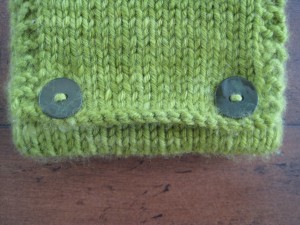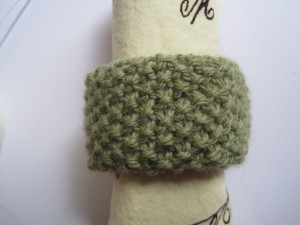In my last post I talked about how the flap of my Kindle cover is curling at its bottom edge between the buttons. I attributed this to the ultra-soft and squishy yarn I used to knit the cover. However, I neglected to mention that the root cause of the curling is most certainly the fact that the flap is knit in Stockinette stitch.
Stockinette stitch has a natural tendency to curl, which is why I kept two stitches at each side of the flap in garter stitch. I could have added a different stitch at the bottom of the flap to ensure against it curling, but I wanted the absolute simplest of designs, both for ease of knitting and to really highlight the beautiful yarn I chose to use, so I stuck with Stockinette stitch and garter stitch. Also, I didn’t really think curling would be problem at the bottom, especially with the buttons right there (but I was mistaken!).
For anyone who is not a beginning knitter, the fact of Stockinette stitch having a predisposition to curl is a given. I didn’t even realize that I left out that obvious but important fact in my previous post until I got an email from a reader and fellow knitter suggesting that the curl may be due to using Stockinette stitch, which it certainly was! In my experience, however, binding off more tightly does lessen that curling problem, as does using a yarn that is more tightly spun. The yarn I chose to use has so much loft that it exacerbates the Stockinette stitch fabric’s natural inclination to curl. Although my bottom edge is slightly curled, I still don’t find it tragic. The curl is small and I don’t think it will get any worse because the two buttons “contain” it.
Of course the best way to ensure against curling edges is to not use Stockinette stitch at those edges. If you’ve been following along with my ramblings, you already know that I’m a big fan of seed stitch. Like garter stitch, seed stitch is a simple stitch, although it’s not quite as easy as garter stitch. However, for just a little work–keeping track of and alternating knits and purls–you get an elegant and refined stitch that is perfect for edgings.1 A fellow knitter did just that for her Kindle cover: she added seed stitch at the top edge of the pouch part and also used it along the flap’s sides and bottom. Check back in the coming days for details and photos of her Kindle cover–it’s just lovely and a great example of how you can adapt a pattern to suit your preferences (or to combat curling edges)!
[simple_series title=”See all my posts on designing and knitting a Kindle e-reader cover:”]




Pingback: Kindle E-reader Cover: A Lovely Variation with Seed Stitch | MakerKnit.com